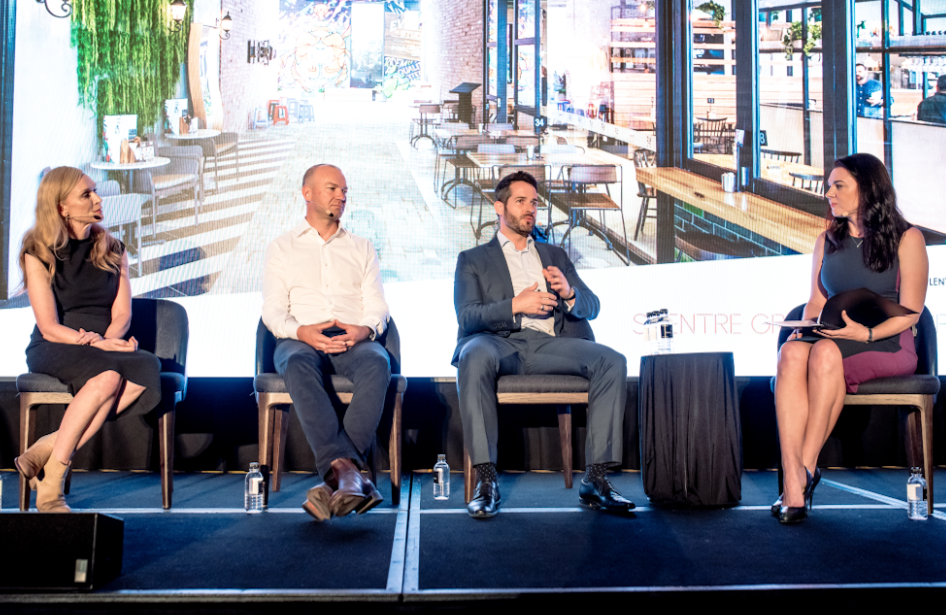Insiders from Australia’s leading shopping centre chain provide insights into how they’re changing with the times to revolutionise the customer experience.
With more than $50 billion in assets and 41 shopping centres across Australia and New Zealand, Scentre Group’s Westfield is one of the biggest shopping centre chains in Australia.
Since the company’s first shopping centre opened in the 1960’s, the brand has transformed significantly as the retail landscape changes alongside consumer expectations.
As the retail industry evolves, the company is entering a new phase of retail with a focus on immersive customer experiences, data-driven customer insights and personalised services, a panel from Westfield’s parent company, Scentre Group, told the audience at Mumbrella’s Retail Marketing Summit last Thursday.
In its bid to deliver consumers an unforgettable retail experience, the company is always looking for new ways to personalise services and improve the shopping experience, Scentre Group’s head of content Bronwyn Cooper told the audience.
“We are very clear of our role as a destination of choice committed to having the best assets, the best locations and one of the best amenity experiences that makes people return again and again,” she said.

“We want our Westfield customers to feel their local Westfield centre is akin to their second home.”
The brand is committed to transforming their shopping centres to align with the new retail world by designing them to suit the demographic of particular suburbs, Sally McBean, head of creative and interior design at Scentre Group told the audience.
“What we do when designing centres is we look first at the demographic of the customer. We have a wonderful research team that gives beautiful data about our shoppers and we collate that data and turn that into something we can relate to,” she said.
But keeping up with changing consumer and retail expectations is all about challenging traditional boundaries around what a shopping centre is, Ms McBean said.
“We need to ask how we can de-shopping centre-ize – so all of these things we don’t normally do like a mural or massive water features that are sky lights and ponds at same time, we are constantly trying to emulate resorts, constantly asking ourselves ‘does this look too much like a shopping centre?’ We push ourselves all the time,” she said.
This focus on an unforgettable, customised shopping centre experiences has meant that over the past few years there has been a targeted focus on personalised design, Ms McBean said. One centre in Coomera, Queensland, for example, features a vibrant red mural on its exterior made be a local artists, aimed at showcasing the rich culture in the region.

“We’re living in a sensory world, so we want people to feel it, smell it, experience our shopping centres,” she said.
“With every centre we work on we look to the local community for our inspiration. With regard to the artwork at Coomera, we tried to engage with local artists wherever possible and we’ve been doing that more and more with centres.”
The centre is also exploring experiential retailing by integrating highly interactive and multipurpose spaces in the centre to think about how they can create an experience that is “meaningful and rich rather than just a transaction,” she says.
One shopping centre, for example, has an egg-like installation structure in one of its outdoor spaces, which, when under cover, has light projections, she says. But the feature can also have a brand activation beneath it , and during the day can be transformed into a playground.
With many brands looking to engage with consumers experientially, Ms McBean says that the centre often partners with brands on campaigns and pop-ups in these interactive spaces in the centres.
“We create physical experiences in a physical world and so we create physical experiences for that to actually happen. It’s about us working together in order to accomplish that,” she said.
Humanised experiences
The chain is also look at extending the customer experience at centres beyond merely the retail experience and towards humanised and place-centred experiences, according to Chris Zerial, centre manager at Westfield Hornsby.
Westfield Hornsby, for example, was struggling with youth crime. Instead of taking on the traditional approach of issuing place bans to the local students, the centre management worked with the local CYC and schools to change behaviours.
The program was a huge success, with a significant drop in the incidence of crime at the centre. This is just one example of the centre’s approach to customer experience.
“There’s so much of what we do just outside physical retail component to engage with the community,” he said.
Customer listening through data
Centre management also leverage CX feedback tools to gain complex insights into customers’ experiences of Westfield shopping centres to improve their shopping experience, Mr Zerial said.
“We’ve gone through a transition where retailers used to be our customer and now we see customers as our customer. All of the data we get from them now we seek and want desperately,” he said.
“Recently we launched something called CX Loop which is an aggregating platform that pulls data from open sources and feedback from the internet and gives us on avg 7,000 pieces of information on who comes through.”
It’s this feedback that helps Westfield to “curate” their experiences, Mr Zerial said.
“Everyone of our centres is so different and varied and we’re really honest and genuine about the strength of each asset.”
This process of data-driven insights, as well as listening to consumers on the ground, is at the heart of Westfield’s strategy, Ms Cooper said.
“We are very committed to customer listening and understanding what parts of the experience are working and what aren’t,” she said.

